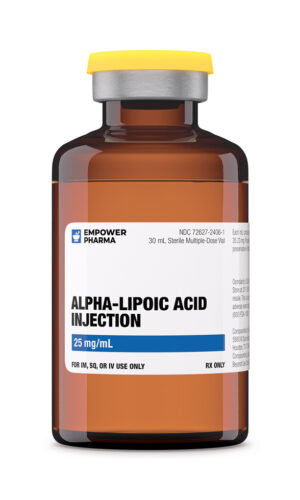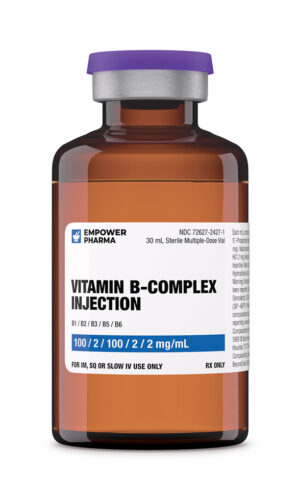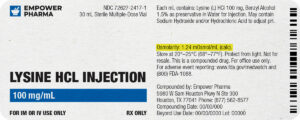


Cobalamins are vitamin B12 which can only be synthesized by microorganisms and can only be sourced from animal product-based diet. Deficiency of cobalamin can cause megaloblastic anaemia which could be related to deficient intake of vitamin B12 or deficient intrinsic factor, among other factors. The type of anaemia, resulting from lack of intrinsic factor is referred to as pernicious anaemia. L. D. Smith and U. Garg, “Disorders of vitamins and cofactors,” in Biomarkers in Inborn Errors of Metabolism, Elsevier, 2017, pp. 361–397.
Hydroxocobalamin (OHCbl) is a natural form of vitamin B12 which is available commercially. It is administrated parenterally either as an intravenous or intramuscular injection. This form of cobalamin is bioidentical to the B12 forms occurring in human physiology. C. Paul and D. M. Brady, “Comparative Bioavailability and Utilization of Particular Forms of B12 Supplements With Potential to Mitigate B12-related Genetic Polymorphisms.,” Integr. Med. (Encinitas)., vol. 16, no. 1, pp. 42–49, Feb. 2017. Initially present as a manufacturing impurity and result of photolysis in commercial cyanocobalamin (under the trade name Cytamen), A. G. Freeman, “Optic Neuropathy and Chronic Cyanide Intoxication: A Review,” J. R. Soc. Med., vol. 81, no. 2, pp. 103–106, Feb. 1988. hydroxocobalamin was later found to be superior for many clinical conditions.
Doses of OHCbl are quite efficient for prevention and treatment of pernicious anaemia, as an antidote in cases of cyanide poisoning as well as for the treatment of Leber’s optic atrophy and tobacco amblyopia. Pernicious anaemia is a fatal condition where deficiency of vitamin B12 affects generation of healthy red blood cells and proper functioning of nervous system. “Pernicious Anemia,” National Heart, Lung, and Blood Institute; National Institutes of Health; U.S. Department of Health and Human Services. [Online]. Available: https://www.nhlbi.nih.gov/health-topics/pernicious-anemia. [Accessed: 16-Aug-2020]. In some individuals, an auto-immune response, inhibits production of a protein called intrinsic factor which is present in normal stomach secretion. It is responsible for vitamin B12 absorption and its absence causing clinical manifestation of its deficiency. Surgery involving stomach areas where cells responsible for intrinsic factor are affected could also lead to loss of B12 absorption. Besides this, several diseases like celiac disease, Crohn’s disease as well as HIV can interfere with vitamin B12 absorption. Others causes include wrong types of bacteria in small intestine, some antibiotics and B12 feeding tapeworm. P. A. McINTYRE, “Pathogenesis and Treatment of Macrocytic Anemia,” AMA. Arch. Intern. Med., vol. 98, no. 5, p. 541, Nov. 1956.
OHCbl is found to be safe and cost effective along with being efficient against pernicious anaemia to be listed as an anti-anaemic in the list of essential medicines for children published by W.H.O. “WHO Model List of Essential Medicines for Children,” World Health Organization Model List of Essential Medicines for Children, 7th List, 2019.
As an antidote for cyanide poisoning, hydroxocobalamin has shown many benefits over alternative antidotes. It has a very rapid response, its by-products are non-toxic and can be easily eliminated from the body, it can be used safely even with non-poisoned patients and it does not affect oxygen carrying capability of blood. It has a long history of being used as an anti-dote safely against cyanide poisoning. M. Dobss, “Cyanide,” in Clinical Neurotoxicology, Elsevier, 2009, pp. 515–522. The only limitation is that it needs to be administered intravenously for a significant period of time and might need a hospital setting.
Tobacco amblyopia is caused by tobacco consumption and can be treated with hydroxocobalamin. A notable difference of improved visual acuity and color vision was reported when OHCbl was administrated IM in patients suffering from it and the performance was superior to cyanocobalamin. I. Chisholm, J. Bronte-Stewart, and W. Foulds, “HYDROXOCOBALAMIN VERSUS CYANOCOBALAMIN IN THE TREATMENT OF TOBACCO AMBLYOPIA,” Lancet, vol. 290, no. 7513, pp. 450–451, Aug. 1967.
Hydroxocobalamin should be used with caution in patients with any known anaphylactic reaction to the drug or any of the formulation components. S. Dally and M. Gaultier, “[Anaphylactic shock caused by hydroxocobalamin].,” Nouv. Presse Med., vol. 5, no. 30, p. 1917, Sep. 1976. It is also contraindicated for patients hypersensitive to cobalt and cyanocobalamin. Cases have been reported where patients who tolerated cyanocobalamin without any adverse effects were found to be allergic to hydroxocobalamin. G. Hovding, “Anaphylactic reaction after injection of vitamin B12.,” BMJ, vol. 3, no. 5610, pp. 102–102, Jul. 1968.
Vitamin B12 deficiency can suppress the symptoms of polycythemia vera. Treatment with hydroxocobalamin, or cyanocobalamin, may unmask this condition. “Hydroxocobalamin injection package insert.” Parsippany, NJ, Actavis Pharma, Inc.
Postmarketing reports have associated intravenous hydroxocobalamin therapy when used as a cyanide antidote with the development of renal impairment and crystalluria with hemodialysis being necessary in some cases for recovery. It is recommended to monitor the renal function during of the patients for 7 days following administration of hydroxocobalamin. “CYANOKIT.” Product label: CYANOKIT (hydroxocobalamin) injection, powder, lyophilized, for solution [Meridian Medical Technologies, Inc.] Last revised: Dec 2019 [DailyMed].
Because of rapid restoration of erythropoiesis in the bone marrow when severe megaloblastic anaemia is treated with hydroxocobalamin, hypokalemia, that is, low serum potassium can occur. O. J. Ayodele, “Megaloblastic Anemia,” in Current Topics in Anemia, InTech, 2018.R. Hesp, I. Chanarin, and C. E. Tait, “Potassium Changes in Megaloblastic Anaemia,” Clin. Sci., vol. 49, no. 1, pp. 77–79, Jul. 1975.] Use of hydroxocobalamin for treating megaloblastic anaemia in combination with folate is also known to cause tremors and thrombocytosis. J. Chandra et al., “Tremors and thrombocytosis during treatment of megaloblastic anaemia,” Ann. Trop. Paediatr., vol. 26, no. 2, pp. 101–105, Jun. 2006. Therefore, potassium levels and platelet counts should be closely monitored when hydroxocobalamin is used for treatment of megaloblastic anaemia.
The red colour induced by OHCbl can interfere in several lab reports including bilirubin, creatinine, magnesium, serum iron, serum aspartate aminotransferase, COHb, methemoglobin, and oxyhemoglobin tests. Caution is advised when being administered to dialysis patients since it can also create a false alarm within dialysis machines and shuts down the machine due to what is referred to as “blood leak.” M. Sutter, N. Tereshchenko, R. Rafii, and G. P. Daubert, “Hemodialysis Complications of Hydroxocobalamin: A Case Report,” J. Med. Toxicol., vol. 6, no. 2, pp. 165–167, Jun. 2010.
Hydroxocobalamin can absorb visible UV light and therapy with this medication may cause photosensitivity. Its use can induce erythema and although it is unknown whether hydroxocobalamin-induced erythema increases the risk for photosensitivity, it is recommended that patients avoid direct sunlight until the redness of skin causes by usage of hydroxocobalamin has resolved. “CYANOKIT.” Product label: CYANOKIT (hydroxocobalamin) injection, powder, lyophilized, for solution [Meridian Medical Technologies, Inc.] Last revised: Dec 2019 [DailyMed].
Simultaneous administration of blood products including whole blood, packed red cells, platelets, and fresh frozen plasma, in the same intra venous line as hydroxocobalamin should be avoided. K. R. Jones, “Hydroxocobalamin (Cyanokit),” Adv. Emerg. Nurs. J., vol. 30, no. 2, pp. 112–121, Apr. 2008.
Hydroxocobalamin is FDA approved for use in pregnant patients in case of cyanide poisoning included suspected cases since 2010. Although adequate studies have still not been performed to ascertain its safety profile and some animal models have shown increased mortality of foetus in high doses, it’s the only anti-dote known to be safe enough to be used in pregnant patients in case of cyanide toxicity. It can not only eliminate effects of cyanide but also helps reduce effects of carbon monoxide which may have co-occurred especially in case of fire victims. E. J. D. Roderique, A. A. Gebre-Giorgis, D. H. Stewart, M. J. Feldman, and A. L. Pozez, “Smoke Inhalation Injury in a Pregnant Patient,” J. Burn Care Res., vol. 33, no. 5, pp. 624–633, 2012.
For any other use, hydroxocobalamin is pregnancy category C drug and should be used only if the potential benefit outweighs the potential risk to the foetus. “Hydroxocobalamin injection package insert.” Parsippany, NJ, Actavis Pharma, Inc.
As per WHO Model List of Essential Drugs when used as an anti-anaemic hydroxocobalamin is compatible with breastfeeding.“BREASTFEEDING AND MATERNAL MEDICATION Recommendations for Drugs in the Eleventh WHO Model List of Essential Drugs.” During treatment for cyanide poisoning with hydroxocobalamin, however, breastfeeding is not recommended since it may be excreted from breast milk and could carry cyanide with it. There is no data to determine when breastfeeding may be safely restarted following administration. “CYANOKIT.” Product label: CYANOKIT (hydroxocobalamin) injection, powder, lyophilized, for solution [Meridian Medical Technologies, Inc.] Last revised: Dec 2019 [DailyMed].
Bacillus Calmette-Guerin Vaccine, BCG medications known to cause bone marrow suppression (e.g., myelosuppressive antineoplastic agents) may result in a blunted or impeded response to hydroxocobalamin, vitamin B12 therapy. “BCG live – Drug Summary,” PDR, LLC. .
Limited evidence from case reports indicate that chloramphenicol which is a bacteriostatic antibiotic can interfere with the red blood cell response to supplemental vitamin B12 in some patients through interference with erythrocyte maturation.“Natural Medicines Comprehensive Database.” [Online]. Available: https://naturalmedicines.therapeuticresearch.com/. [Accessed: 29-Aug-2020].
Although generally useful for cancer patients it has been known to interfere with chemotherapy by depletion of extracellular cysteine in combination with ascorbate. H. F. Pierson, J. M. Fisher, and M. Rabinovitz, “Depletion of Extracellular Cysteine with Hydroxocobalamin and Ascorbate in Experimental Murine Cancer Chemotherapy,” Cancer Res., vol. 45, no. 10, pp. 4727 LP – 4731, Oct. 1985.
Metformin, used in treatment of diabetes, can possibly affect the intestinal cells involved in intrinsic factor metabolism and calcium dependent absorption of vitamin B12 leading to reduced assimilation of the vitamin. It may also occur due to other factors such as increased bacterial overgrowth.D. R. Buvat, “Use of metformin is a cause of vitamin B12 deficiency.,” Am. Fam. Physician, vol. 69, no. 2, pp. 264; author reply 264, 266, Jan. 2004.W. A. Bauman, S. Shaw, E. Jayatilleke, A. M. Spungen, and V. Herbert, “Increased intake of calcium reverses vitamin B12 malabsorption induced by metformin.,” Diabetes Care, vol. 23, no. 9, pp. 1227–31, Sep. 2000.
Histamine H2 receptor antagonists used to treat peptic ulcer disease and proton pump inhibitors used to treat gastroesophageal reflux disease can affect absorption of B12 and it is recommended to monitor the vitamin status in patients using them for prolonged periods. “Vitamin B12 Fact Sheet for Health Professionals.” [Online]. Available: https://ods.od.nih.gov/factsheets/vitamin B12-HealthProfessional/#en86. [Accessed: 29-Aug-2020]. Antineoplastics are antimetabolites for B12 can reduce its hematologic response. “Nursing Central,” Unbound Medicine, Inc. [Online]. Available: https://nursing.unboundmedicine.com/nursingcentral/view/Davis-Drug-Guide/109246/13/hydroxocobalamin. [Accessed: 08-Feb-2020].
Hydroxocobalamin has been found to be physically incompatible when mixed in solution with diazepam, dobutamine, dopamine, fentanyl, nitroglycerin, pentobarbital, propofol, and thiopental. It is chemically incompatible with sodium thiosulfate, sodium nitrite, and ascorbic acid. K. R. Jones, “Hydroxocobalamin (Cyanokit),” Adv. Emerg. Nurs. J., vol. 30, no. 2, pp. 112–121, Apr. 2008.
Reddening of skin, allergic reactions, headache, and erythema at injection site are some common side effects of this drug. OHCbl has been known to induce chromaturia in healthy volunteers. However, red coloured urine is harmless and resolves itself within 2 to 3 days but it can interfere with laboratory tests.
Anaphylactic reaction has been observed and documented in some patients but discontinuation of therapy resolved the symptoms within few weeks. It has been observed that predisposing factor in certain patients might lead to these symptoms.J. E. Dimmel, A. Patel, J. F. Clark, V. S. Bhave, E. Samuel, and V. Mody, “Vitamins, amino acids, and drugs and formulations used in nutrition,” 2019, pp. 387–400.
Transient increase in blood pressure also has been seen due to hydroxocobalamin’s inhibition of nitric oxide synthase and direct clearing of nitric oxide from the blood. However, it is generally considered beneficial and should not be treated but close observation is recommended.E. J. D. Roderique, A. A. Gebre-Giorgis, D. H. Stewart, M. J. Feldman, and A. L. Pozez, “Smoke Inhalation Injury in a Pregnant Patient,” J. Burn Care Res., vol. 33, no. 5, pp. 624–633, 2012.
No allergic effects against OHCbl were seen in a study W. Uhl, A. Nolting, G. Golor, K. Ludwig Rost, and A. Kovar, “Safety of Hydroxocobalamin in Healthy Volunteers in a Randomized, Placebo-Controlled Study,” Clin. Toxicol., vol. 44, no. sup1, pp. 17–28, Jan. 2006. at dosages below 2.5 gm although higher dosages from 5 g to 7.5g showed effects in few volunteers ranging from itching, facial erythema, swelling, eye reddening, shivering, dyspnoea, facial oedema and spontaneous exanthema. Pustular rash was most common among the side effects. Generally, clinically serious cases effects are not seen with OHCbl, however in rare cases anaphylactic shock and loss of consciousness have been observed even with small dosages when used in treatment of pernicious anaemia in patients which were known to be tolerant to cyanocobalamin. G. Hovding, “Anaphylactic reaction after injection of vitamin B12.,” BMJ, vol. 3, no. 5610, pp. 102–102, Jul. 1968.
Store this medication at 68°F to 77°F (20°C to 25°C) and away from heat, moisture and light. Keep all medicine out of the reach of children. Throw away any unused medicine after the beyond-use date. Do not flush unused medications or pour down a sink or drain.








